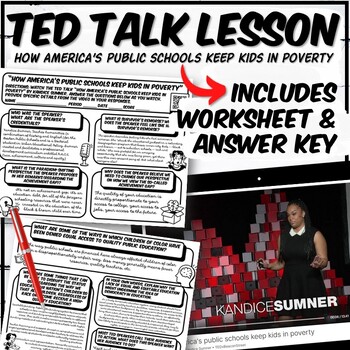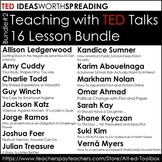TED Talk Lesson (How America's Public Schools Keep Kids in Poverty)
- PDF
Also included in
- This TED Talk Lesson Bundle contains 16 TED Lessons and activities. TED lessons may be used as mini-lessons, supplements to a prepared lesson or unit, one-day lessons for in-between units, or sub-day lesson plans. Most TED Talks are less than 18 minutes long, allowing time to watch the TED Talk in cPrice $8.00Original Price $18.72Save $10.72
- TED Talk lessons make great supplements to planned units, great mini-lessons, and great "sub day" lessons! This growing TED Talk Lesson Bundle includes over 40 TED Talk lessons and activities. As an alternative education teacher, I strive to create lessons that are interesting and meaningful to thePrice $16.00Original Price $61.22Save $45.22
Description
TED Talk Lesson: How America’s Schools keep kids in Poverty, Kandice Sumner
WHAT’S INCLUDED
Worksheet (Print Back-to-Back) with QR code linking to TED Talk
Answer Key
TED Talk One-Pager Activity (Instructions, rubric, & templates, sample)
SUGGESTED USES:
The TED Talk "How America’s Public Schools Keep Kids in Poverty" by Kandice Sumner can be used as a supplementary resource in various high school courses to spark discussions and provide insights into educational equity and social issues.
1. Social Studies/Civics/Government: Use the TED Talk to explore the intersection of education and social issues, discussing how educational inequalities can impact democratic participation and civic engagement.
2. Sociology: Analyze the TED Talk in the context of sociological theories and concepts related to social stratification, poverty, and its effects on educational opportunities.
3. American History: Examine the historical context of educational disparities in the United States, discussing how historical policies and practices have shaped the current educational landscape.
4. Economics: Explore the economic implications of unequal education and how addressing educational disparities can impact economic growth and social mobility.
5. English/Literature: Pair the TED Talk with relevant literature or essays that address educational equity and social justice themes, encouraging critical analysis and writing assignments.
6. Psychology: Discuss the psychological impact of poverty on students' academic performance and well-being and explore potential interventions to support students from disadvantaged backgrounds.
7. Race and Ethnic Studies: Analyze the intersection of race, ethnicity, and socioeconomic status in relation to educational opportunities, drawing on examples from the TED Talk.
8. Current Events/Debates: Incorporate the TED Talk into discussions about current events related to education policy, funding, and initiatives aimed at reducing educational inequalities.
From TED:
Why should a good education be exclusive to rich kids? Schools in low-income neighborhoods across the US, specifically in communities of color, lack resources that are standard at wealthier schools — things like musical instruments, new books, healthy school lunches and soccer fields — and this has a real impact on the potential of students. Kandice Sumner sees the disparity every day in her classroom in Boston. In this inspiring talk, she asks us to face facts — and change them.




